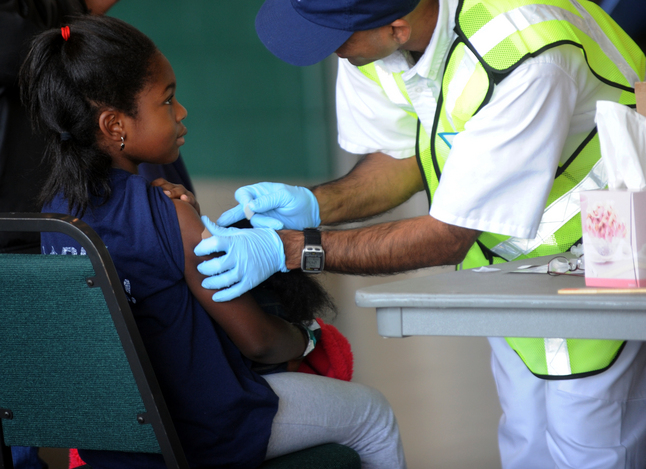
Michaela Glenn of Ann Arbor gets a band aid after receiving the H1N1 vaccination at the Eastern Michigan University Convocation Center during the swine flu outbreak in 2009.
Melanie Maxwell | AnnArbor.com file photo
Absenteeism rates are not indicative of an abnormal flu season at Ann Arbor Public Schools, but reports of a national influenza epidemic have led the district to increase its tracking of flu-related absences.
Director of Communications Liz Margolis said on any given day last week, all of the district’s buildings reported less than 5 percent of its students were absent or called in sick.
Rates of teacher absences were not available Friday, but Margolis said the district’s human resources department reported rates appear normal with no increases. She said the district’s nurses are watching teachers and students’ health very closely.
Michigan health officials have reported four children have died from influenza already this flu season.
“We have seen a higher number of staff members than students (sick) but nothing that has caused us not to have subs or anything like that,” Margolis said. “Our nurses have sent some staff home that have come back to work still coughing and showing symptoms.”
She said this week, nurses reported five teachers at Huron High School were sent home after being considered not well enough yet to be around students.
“But that's all I’ve heard,” Margolis said Friday.
The district currently employs nine school nurses who divide their time among Ann Arbor’s 34 buildings. Nurses have at most four elementary schools or one secondary school and one elementary building assigned to them, Margolis said.
Nurses are in frequent contact with Margolis and central administration throughout flu season. Protocols are in place to monitor the illness among students. Main office staff at the elementary schools and attendance office staff at the high schools notify nurses when they start to see an uptick in the number of families reporting flu-like symptoms.
Starting in 2009 with the outbreak of the H1N1 flu virus, which disproportionately infected school-aged children, AAPS changed how it reported illness-related absences in PowerSchool, the district’s attendance program, Margolis said. The district began asking parents to indicate whether their child was experiencing flu-like symptoms.
Ann Arbor then reports weekly the number of students who are absent due to illness to Washtenaw County Public Health, Margolis said.
Because national reports have indicated the U.S. currently is experiencing an above-average flu season and entire cities, such as Boston, have declared public health emergencies due to the flu, AAPS is taking extra precautions — just to be on the safe side.
Margolis said Superintendent Patricia Green has asked district administrators to start monitoring the schools’ absenteeism rates on a weekly basis. Generally, the oversight of flu-related absences occurs at the building level, until a building reaches a situation where 20 percent of its student body is absent, then central administration takes a more active role in monitoring.
“And that’s when we start talking about closing schools,” Margolis said. “But it really depends on the school, and are we seeing classrooms with 10 kids out or more — there’s a lot to be considered
“There were a couple of years where we had a building creeping up beyond that (20 percent absent rate). But we have not, in my 10 years with the district, ever closed a school for excessive absences,” she said.
In 2009, AAPS designated one nurse to be the H1N1 nurse and to watch the district’s cases of reported H1N1 influenza, Margolis said.
Washtenaw County Public Health epidemiologist Laura Bauman said health officials are mostly seeing the Type A influenza strain, or H3N2, the most severe strain, this year. Bauman said every flu season is unique, but generally this strain infects older adults.
“But I won’t know for a few more weeks how it’s really impacting children,” she said. “What can happen is there is a little bit of a lull. The children were out of school. And then everybody is coming back to school and sharing all of the bugs they picked up over the holidays.”
Whooping cough, norovirus, influenza — “There is a lot going on out there right now,” Bauman said, adding schools are reporting their absences to County Public Health Friday and Monday, so she should have more data and information on how children are faring by mid- to end-of-the-week this week.
There have been 43 Washtenaw County residents hospitalized for the flu so far this season. Fifty-six percent of these residents have been 65 or older, 21 percent have been age 50 to 64 and the next most-infected age group has been 18- to 49-year-olds, Bauman said.
Ann Arbor Public Schools distributed hand sanitizer to every classroom, and elementary teachers, who also have sinks in their classrooms, have been instructed to make more designated times throughout the day for hand washing during the typical flu season, Margolis said.
The U.S. Centers for Disease Control and Prevention recently reported the national influenza death rate surpassed the “epidemic” threshold last week. And, as of Friday, Michigan health officials now have 338 confirmed cases of the flu, according to the Associated Press.
Danielle Arndt covers K-12 education for AnnArbor.com. Follow her on Twitter @DanielleArndt or email her at daniellearndt@annarbor.com.